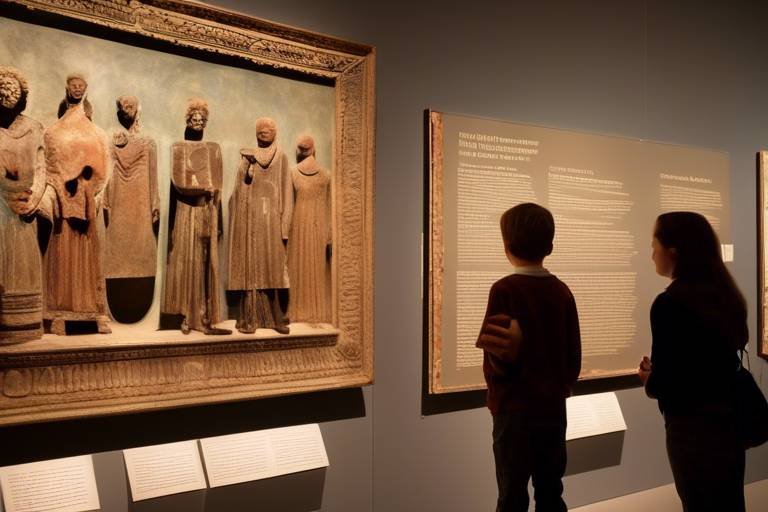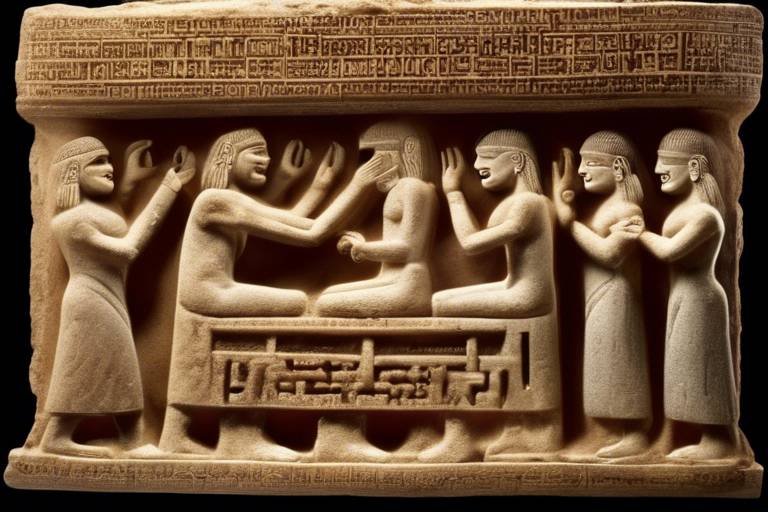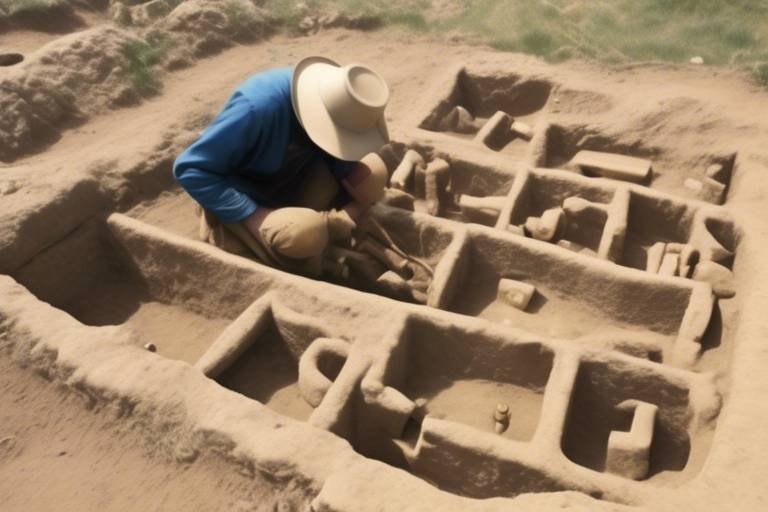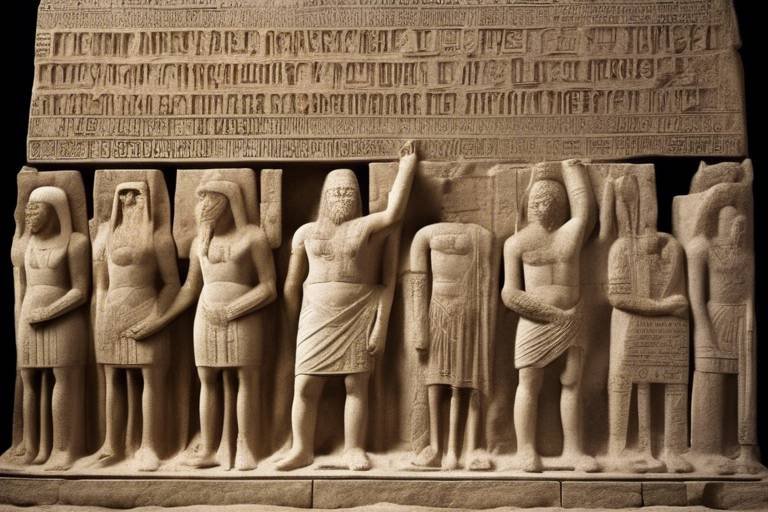The Role of Sacrifice in Ancient Religions
Exploring the significance of sacrificial practices in ancient religious traditions reveals a profound connection between believers and the divine. Sacrifice was not merely an act of offering; it was a profound symbol of devotion, gratitude, and supplication. In ancient civilizations, the act of sacrifice was deeply intertwined with religious beliefs, cultural practices, and societal norms, shaping the spiritual fabric of communities.
Tracing the origins of sacrificial rituals in ancient societies unveils a rich tapestry of traditions that evolved over centuries. From the elaborate ceremonies of the Egyptians to the solemn rites of the Greeks, each civilization imbued sacrifice with symbolic meaning and ritualistic significance. The historical evolution of sacrifice mirrors the evolution of human consciousness, reflecting changes in religious beliefs and cultural values.
Distinguishing between different forms of sacrifice provides insight into the diverse ways in which ancient cultures engaged in this sacred practice. Whether through animal offerings, blood sacrifices, or symbolic rituals, each form of sacrifice carried its unique symbolism and cultural significance. The types of sacrifice varied across civilizations, yet the underlying purpose remained consistent – to establish a connection with the divine and seek blessings for the community.
Exploring the role of ritual sacrifice in Mesopotamian religion unveils a complex interplay of spiritual beliefs, agricultural practices, and social cohesion. In Mesopotamia, ritual sacrifice was intricately linked to the cyclical rhythms of nature, with offerings made to appease deities and ensure bountiful harvests. The act of sacrifice was not only a religious duty but also a means of maintaining order and harmony within the community.
Investigating the controversial practice of human sacrifice among Mesoamerican civilizations like the Aztecs sheds light on the darker aspects of sacrificial rituals. Human sacrifice, while repugnant to modern sensibilities, held profound religious significance for these ancient cultures. It was believed to appease the gods, renew the cosmic balance, and ensure the survival of the civilization. The practice of human sacrifice, though morally contentious, played a central role in shaping Mesoamerican religious beliefs and cultural identity.
Analyzing the symbolic meanings embedded in sacrificial acts reveals a deeper layer of spiritual significance. From the offerings made to deities as expressions of devotion to the symbolic representation of renewal, purification, and atonement, sacrificial symbolism transcended mere material offerings. Each sacrificial act was imbued with profound meaning, reflecting the spiritual aspirations and ethical values of ancient societies.
Discussing the ethical dilemmas surrounding ancient sacrificial practices prompts us to confront the complexities of morality and cultural relativism. While modern perspectives may view ritual sacrifice as barbaric or outdated, it is essential to understand these practices within their historical and cultural contexts. The ethical considerations and controversies surrounding sacrifice invite us to question our own moral convictions and cultural biases, fostering a deeper understanding of the complexities of religious practices.
Examining the concept of sacrifice in Judaism, Christianity, and Islam illuminates the enduring legacy of sacrificial traditions in Abrahamic religions. While the form and interpretation of sacrifice may vary across these monotheistic faiths, the underlying principle of offering oneself in service to the divine remains a central tenet. Sacrifice in Abrahamic religions symbolizes devotion, obedience, and spiritual purification, embodying the profound connection between believers and their faith.

Historical Evolution of Sacrifice
Exploring the historical evolution of sacrificial practices unveils a fascinating journey through the annals of ancient civilizations. The origins of sacrifice can be traced back to the earliest human societies, where offerings were made to appease supernatural forces and ensure the well-being of the community. These rituals evolved over time, reflecting the shifting religious beliefs and cultural norms of each era.
In the ancient world, sacrificial practices played a central role in religious ceremonies and societal structures. From the elaborate rituals of the Egyptian pharaohs to the blood offerings of the Mayans, each civilization had its unique approach to sacrifice. These practices were deeply intertwined with the spiritual beliefs of the people, serving as a means of communication with the divine and a way to maintain cosmic order.
As civilizations advanced, the nature of sacrificial offerings also underwent changes. While early societies primarily engaged in animal sacrifices and symbolic rituals, some cultures, such as the Aztecs, practiced human sacrifice on a large scale. These extreme acts were often justified by religious beliefs, with human lives offered to appease gods and secure favorable outcomes for the community.
Throughout history, the evolution of sacrificial practices has reflected the complex interplay between religion, culture, and societal norms. From the agricultural rites of the Mesopotamians to the ritualistic ceremonies of the Greeks, each civilization contributed to the rich tapestry of sacrificial traditions that shaped the ancient world.

Types of Sacrifice
When delving into the realm of ancient religious practices, one cannot ignore the diverse array of sacrificial rituals that played a pivotal role in shaping belief systems and cultural traditions. Sacrifice, in its various forms, served as a profound expression of devotion, gratitude, and supplication to higher powers in numerous civilizations throughout history.
One of the primary types of sacrifice prevalent in ancient cultures was animal offerings. These rituals involved the presentation of livestock or other animals as a symbolic gesture to appease gods or spirits, seek blessings for a bountiful harvest, or express thanksgiving for divine favor. Animal sacrifices were deeply intertwined with agricultural cycles and seasonal celebrations, reflecting the dependence of ancient societies on the natural world.
Blood sacrifices, another common form of ritual, held significant spiritual significance in many ancient religions. The act of offering blood, often through the slaughter of animals, was believed to establish a sacred connection between the mortal realm and the divine realm. Blood was viewed as a potent symbol of life force and vitality, making it a central element in sacrificial practices across various civilizations.
Symbolic rituals, while less overtly visceral than animal or blood sacrifices, played a crucial role in conveying deeper meanings and intentions through symbolic gestures or offerings. These symbolic acts could range from burning incense or grains to elaborate ceremonies symbolizing renewal, purification, or atonement. Symbolic sacrifices often transcended the physical realm, delving into the realm of metaphysical and spiritual realms.
By understanding the diverse types of sacrifices practiced in ancient civilizations, we gain insight into the rich tapestry of beliefs, traditions, and cultural values that defined these societies. Each form of sacrifice, whether animal, blood, or symbolic, carried profound meanings and served as a bridge between the earthly and the divine, reflecting the complex relationship between humanity and the supernatural.

Ritual Sacrifice in Mesopotamia
Ritual sacrifice in Mesopotamia held a central role in the religious practices of ancient civilizations like the Sumerians, Babylonians, and Assyrians. These societies believed that offering sacrifices to their gods was essential for maintaining harmony between the divine realm and the earthly world. The act of sacrifice was intricately linked to the agricultural cycles, as it was believed to ensure fertility and bountiful harvests. By presenting valuable offerings to their deities, the Mesopotamians sought to appease the gods and secure their favor for the well-being of their communities.
The rituals of sacrifice in Mesopotamia were not only about material offerings but also had symbolic significance. Animals such as sheep, cattle, and goats were commonly sacrificed, with the blood considered a vital element in communicating with the gods. The act of shedding blood symbolized the offering of life itself, a gesture of devotion and submission to the divine forces believed to govern the universe. Through these rituals, the Mesopotamians sought to establish a connection with their gods, seeking protection, prosperity, and order in their society.
Moreover, ritual sacrifice in Mesopotamia played a crucial role in maintaining social order and hierarchy within the community. The performance of sacrificial ceremonies was often overseen by priests or religious officials, who acted as intermediaries between the people and the deities. By participating in these rituals, individuals reinforced their bonds with the divine and affirmed their place in the cosmic order. The communal aspect of sacrifice fostered a sense of unity and collective identity, reinforcing the shared beliefs and values that underpinned Mesopotamian society.
It is important to note that the practice of ritual sacrifice in Mesopotamia was not without controversy and ethical considerations. While the ancient Mesopotamians viewed sacrifice as a sacred duty and a means of divine communication, modern perspectives often raise questions about the morality and necessity of such practices. The cultural significance of sacrifice in Mesopotamia continues to be a subject of scholarly debate, highlighting the complex interplay between religious beliefs, social norms, and ethical values in ancient civilizations.

Human Sacrifice in Mesoamerica
Human sacrifice in Mesoamerica was a deeply ingrained ritual practice among civilizations like the Aztecs, where it held significant religious and social importance. The act of sacrificing human lives was believed to appease the gods, maintain cosmic order, and ensure the continuity of life. It was not merely a barbaric act but a sacred duty performed with solemnity and reverence. The Aztecs viewed human sacrifice as a necessary offering to sustain the balance of the universe, a belief that shaped their cultural identity and societal structure.
The victims chosen for sacrifice were often prisoners of war or individuals from conquered territories, symbolizing the Aztec belief in the cyclical nature of life and death. These sacrificial rituals were meticulously planned and executed, involving elaborate ceremonies, prayers, and symbolic gestures. The blood of the sacrificed individuals was considered a powerful offering to the gods, symbolizing life force and vitality. Through these sacrifices, the Aztecs sought to honor their deities, secure divine favor, and ensure the prosperity of their civilization.
The practice of human sacrifice in Mesoamerica has sparked intense debate and controversy among historians and scholars. While some argue that it was a fundamental aspect of Aztec religious beliefs and cultural traditions, others condemn it as a brutal and inhumane practice. The ethical considerations surrounding human sacrifice raise questions about the value of life, the boundaries of religious freedom, and the complexities of cultural relativism. Understanding the historical context and religious significance of human sacrifice in Mesoamerica is essential for appreciating the complexities of ancient civilizations and their belief systems.

Sacrificial Symbolism
In ancient religious practices, sacrificial symbolism played a crucial role in conveying deeper meanings beyond the physical act of offering. Sacrifices were not merely about the material gift presented to the divine but were laden with symbolic significance that resonated with the believers. The act of sacrifice symbolized a profound connection between the human and the divine, a bridge that allowed for communication and interaction with the spiritual realm.
One common symbolic theme in sacrificial rituals was the notion of renewal and regeneration. Just as the sacrificed animal or object was offered up to the gods, it was believed that this act would bring about a renewal of life, fertility, and prosperity to the community. The symbolism of sacrifice as a means of rejuvenation and growth was deeply ingrained in many ancient cultures, reflecting their cyclical understanding of life and death.
Moreover, sacrificial acts often symbolized purification and atonement for sins or transgressions. By offering a sacrifice, individuals sought to cleanse themselves of impurities, both physical and spiritual, and to seek forgiveness for wrongdoings. The act of sacrifice served as a symbolic gesture of repentance and reconciliation with the divine forces, restoring harmony and balance within the cosmic order.
Additionally, sacrificial symbolism extended to the idea of reciprocity and exchange with the divine. Believers viewed sacrifices as a form of gift-giving to the gods, a way to express gratitude, loyalty, and devotion. In return for their offerings, worshippers expected blessings, protection, and divine favor, creating a reciprocal relationship based on mutual exchange and trust.
Overall, sacrificial symbolism in ancient religions encompassed a rich tapestry of meanings and interpretations, reflecting the complex interplay between the human and the divine realms. These symbolic acts served as a powerful medium through which believers could express their deepest beliefs, values, and aspirations, forging a profound connection with the spiritual forces that governed their lives.

Ethical Considerations and Controversies
When delving into the realm of ancient religious practices, it's impossible to ignore the ethical considerations and controversies surrounding the act of sacrifice. The very notion of offering something valuable, whether it be an animal, a symbolic item, or even a human life, raises profound ethical questions that continue to spark debates among scholars and the general public alike.
One of the primary ethical dilemmas associated with sacrificial practices is the question of consent. In the case of human sacrifice, particularly prevalent in certain ancient civilizations like the Aztecs, the issue of whether individuals willingly offered themselves for the greater good or were coerced into such acts remains a point of contention. The concept of free will versus societal pressure adds layers of complexity to the ethical analysis of these rituals.
Moreover, modern ethical frameworks often clash with the cultural and religious contexts in which sacrificial practices originated. While some view ancient sacrifices as barbaric and morally reprehensible, others argue that these acts held deep symbolic significance within the belief systems of the time. Balancing cultural relativism with universal ethical principles poses a significant challenge when evaluating the morality of ancient sacrificial traditions.
Another aspect of ethical consideration revolves around the treatment of animals in sacrificial rituals. Animal offerings were common in many ancient cultures as a way to communicate with deities or seek divine favor. However, the ethical implications of taking the life of an innocent creature for religious purposes raise questions about the value of animal welfare and the justification for such practices in a contemporary ethical framework.
Furthermore, the controversies surrounding ritual sacrifice extend beyond ethical considerations to encompass broader societal impacts. The practice of sacrifice often played a crucial role in maintaining social order, reinforcing power structures, and solidifying community bonds. However, the exploitation of vulnerable individuals or marginalized groups in sacrificial ceremonies raises serious concerns about social justice and equality within ancient societies.
In the modern era, the legacy of ancient sacrificial traditions continues to provoke discussions on cultural heritage, religious freedom, and the limits of acceptable religious practices. As contemporary societies grapple with diverse ethical perspectives and evolving moral standards, the study of ancient sacrificial practices serves as a poignant reminder of the intricate interplay between faith, tradition, and ethical responsibility.

Sacrifice in Abrahamic Religions
Exploring the concept of sacrifice in Abrahamic religions reveals a complex interplay of tradition, faith, and symbolism. In Judaism, sacrifice historically held a central role in religious practice, with offerings made to God as acts of atonement and devotion. The story of Abraham's willingness to sacrifice his son Isaac, only to be stopped by an angel at the last moment, symbolizes obedience and faith in God's will. This narrative underlines the idea of ultimate sacrifice and trust in divine providence.
In Christianity, the significance of sacrifice takes on a profound theological dimension through the crucifixion of Jesus Christ. His sacrificial death on the cross is viewed as an act of redemption and salvation for humanity, embodying the ultimate sacrifice for the forgiveness of sins. The Eucharist, a central sacrament in Christian worship, commemorates this sacrifice through the symbolic sharing of bread and wine, representing the body and blood of Christ.
Islam also incorporates the concept of sacrifice in its religious observances, particularly during Eid al-Adha, the Festival of Sacrifice. This festival commemorates the willingness of Prophet Ibrahim (Abraham) to sacrifice his son Isma'il (Ishmael) as an act of obedience to God. Muslims worldwide participate in the ritual sacrifice of an animal, symbolizing their willingness to submit to God's commands and share with those in need.
Across these Abrahamic faiths, the notion of sacrifice transcends mere ritualistic practice to embody deeper spiritual meanings. It underscores themes of obedience, redemption, and submission to divine will, serving as a symbolic link between believers and their respective traditions. The act of sacrifice in Abrahamic religions thus serves as a powerful expression of faith and devotion, uniting followers in shared beliefs and practices.
Frequently Asked Questions
- What is the significance of sacrifice in ancient religions?
The act of sacrifice in ancient religions held various meanings, including offerings to deities, expressions of devotion, renewal, purification, and atonement. It played a crucial role in religious rituals, cultural practices, and social order within communities.
- How did sacrificial practices evolve over time?
Sacrificial rituals in ancient societies evolved alongside changes in religious beliefs and cultural norms. The types of sacrifices, such as animal offerings, blood sacrifices, and symbolic rituals, varied across civilizations and reflected the spiritual and social dynamics of the time.
- What were the ethical considerations surrounding ancient sacrificial practices?
Ancient sacrificial practices often raise ethical dilemmas due to modern perspectives on morality. While some view ritual sacrifice as a cultural tradition and religious duty, others question the moral implications of sacrificing animals or humans for religious purposes.



















